The Economics and Statistics Division maintains archives of previous publications for accountability purposes, but makes no updates to keep these documents current with the latest data revisions from Statistics Canada. As a result, information in older documents may not be accurate. Please exercise caution when referring to older documents. For the latest information and historical data, please contact the individual listed to the right.
<--- Return to Archive
For additional information relating to this article, please contact:
November 16, 2021HOUSING STARTS, OCTOBER 2021 With October reference month results, year-over-year (October 2021 vs October 2020) and year-to-date (Jan-Oct 21 vs Jan-Oct 20) are in part showing the rebounds in economic activity from the unprecedented declines observed at the start of the COVID-19 pandemic.
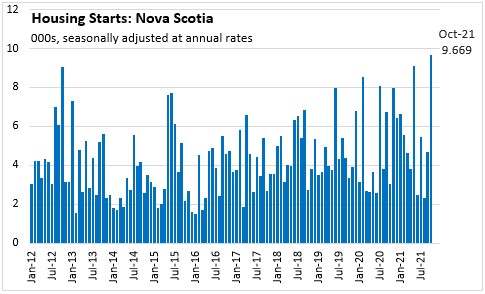
Nova Scotia’s housing starts (seasonally adjusted annualized rate) totalled 9,669 units in October 2021, the highest monthly housing starts units on record since January 1990. This was 107.2% above the revised 4,667 units started in September 2021. Housing starts in Halifax increased from 2,794 units to 7,699 (approximately three-fold increase). Outside of Halifax, housing starts were up from 1,873 units in September to 1,970 units in October.
Compared to October 2020, Nova Scotia’s housing starts were 219.6% higher with a 468.2% increase in Halifax and a 18.0% increase outside of Halifax.
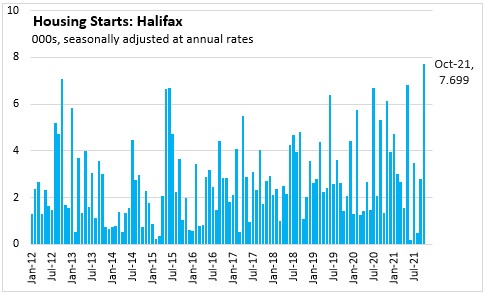
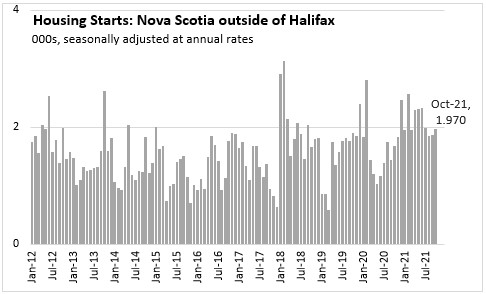
Housing starts trended down across the province in the first half of 2020 before rebounding in the summer of 2020. From the summer of 2020 through spring 2021, housing starts were at elevated levels across the province. Over the summer of 2021, housing starts slowed significantly in the Halifax market while the decline outside the city had been slower. In recent months housing starts are at elevated levels in Halifax while the increase outside the city has been slower.
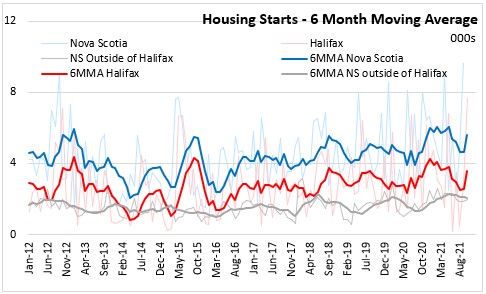
In urban areas, housing starts for multiples are generally higher than for singles with greater variability month-to-month. The six-month moving average for singles had trended upward since early 2019 before a modest moderation in 2021. The six-month moving average for multiples rose during the summer months of 2018 and declined until the first quarter of 2019. After a period of fluctuation in 2019 and 2020, the six-month moving average for multiples had been at an elevated level in the first half of 2021 and trended downward in summer 2021. However, the six-month moving average for singles and multiples have trended upward in recent months.
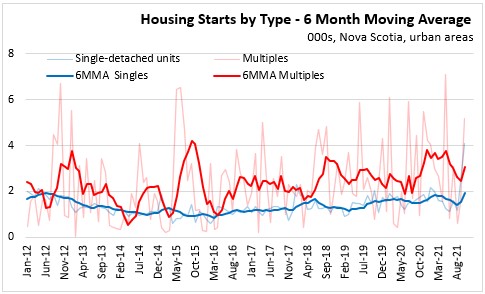
In Canada, housing starts decreased 5.3% from the previous month to 236,554 units in October 2021. When compared to October 2020, housing starts in Canada were up 4.1%.

From September to October, housing starts were up in five provinces. Prince Edward Island (+128.2%) and Nova Scotia (+107.2%) reported the largest monthly increases in housing starts while Saskatchewan (-58.2%) and Manitoba (-44.7%) reported the largest monthly declines.
During the first ten months of 2021, Nova Scotia's housing starts were up 21.0% compared to the same period last year. Halifax housing starts increased 13.8% while starts outside the city were up 34.4%. Canada’s housing starts increased 30.0%. Housing starts rose in all provinces with Newfoundland and Labrador posting the strongest growth (+77.5%), and Prince Edward Island (+15.6%) the slowest.
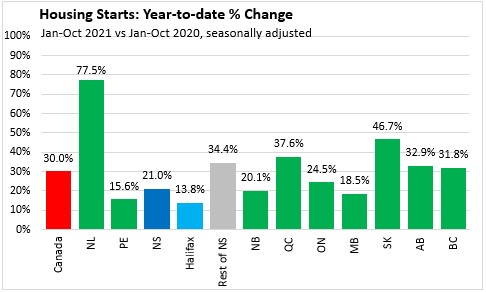
Note: Urban areas are defined as areas over 10,000 people
Source: Statistics Canada, Table 34-10-0135-01 Canada Mortgage and Housing Corporation, housing starts, under construction and completions, all areas, quarterly; Table 34-10-0158-01 Canada Mortgage and Housing Corporation, housing starts, all areas, Canada and provinces, seasonally adjusted at annual rates, monthly (x 1,000) ; Table 34-10-0156-01 Canada Mortgage and Housing Corporation, housing starts in all centres 10,000 and over, Canada, provinces, and census metropolitan areas, seasonally adjusted at annual rates, monthly (x 1,000)
<--- Return to Archive